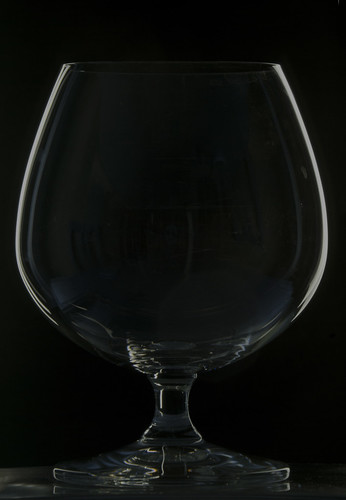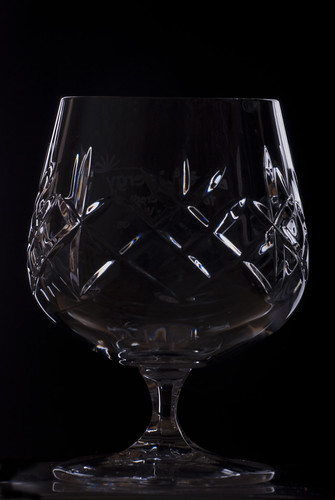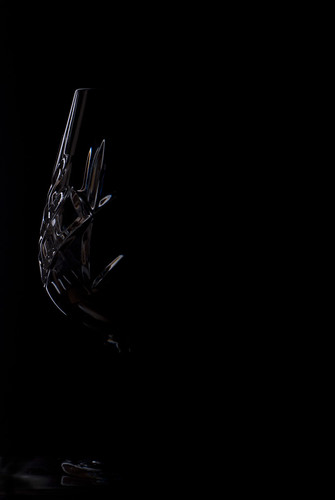In this case I wanted to have another try at the lighting exercise and have a go at a combined dark field and edge lighting experiment.,
I setup the softbox behind a piece of A4 black paper which was clamped to a lighting stand a little in front of the softbox.

I am pleased with the colouration of the brandy and that the curviture of the inside of the glass is shown by the small amounts of defracted light within the glass itself.
Large Brandy Glass
I then moved on to a larger glass, one which was almost as wide as the piece of black paper once it was composed on the table.
D80, Aperture f27, Speed 1/180 sec, ISO 100, 95mm (35mm Equivalent 142mm), Matrix Metering Mode, Flash White Balance, tripod mounted, 55-200mm,Single Studio 180W Flash head with softbox.
Large Brandy Glass
I then moved on to a larger glass, one which was almost as wide as the piece of black paper once it was composed on the table.
D80, Aperture f27, Speed 1/180 sec, ISO 100, 95mm (35mm Equivalent 142mm), Matrix Metering Mode, Flash White Balance, tripod mounted, 55-200mm,

I converted it to black and white and then used photoshop to adjust the saturation colour on the glass to give it a very slight blue hue as I wanted to show the bowl shape of the glass.
Crystal Glass
Again I changed glasses, this one was slighly smaller, but it had the one advantage of being cut crystal. This allowed the light to reflect around more within the glass as the crystal cuts helped to deflect and disfuse the light.
D80, Aperture f27, Speed 1/180 sec, ISO 100, 105mm (35mm Equivalent 157mm), Matrix Metering Mode, Flash White Balance, tripod mounted, 55-200mm,

While I was pleased with the glass and the light effect it produced I was not too happy to see that a lot of the table below the stand and the glass was being reflected up into the bottom of the glass. Next time I will have to place down non reflective black card to stop the reflections and to soak up some of the bounced light.
Crystal Glass Single Side
I adjusted the glass and the lighting stand holding the black piece of paper a little and then had another go at the crystal glass, this time I wanted only to capture one side of the glass.
D80, Aperture f27, Speed 1/250 sec, ISO 100, 105mm (35mm Equivalent 157mm), Matrix Metering Mode, Flash White Balance, tripod mounted, 55-200mm,

Using the slightly faster shutter speed meant that with the adjustments I photographed the glass capturing only the light refelecting from once side. I was really pleased with this image.
What I learned